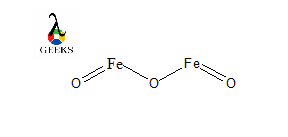Iron oxide is an inorganic compound that is also known as hematite. Let us talk about the various properties: physical and chemical properties of iron oxide have to discuss.
Iron oxide naturally occurs in rocks. It is obtained from the oxidation of iron. It is important in biological activities. Iron oxide is soluble in strong acids like hydrochloric acid and sulphuric acid and insoluble in water. The pH of iron oxide is 7.
Now in this article, we will discuss the boiling point, melting point, oxidation state, polarity, conductivity, molar mass, color, viscosity, and nature of the bond with proper explanations.
Iron Oxide IUPAC Name
The IUPAC name (International Union of Pure and Applied Chemistry) of iron oxide is iron oxide itself.
Iron Oxide Chemical Formula
Iron oxide has the chemical formula Fe2O3. Each iron atom is attached to two oxygen atoms in this formula by a single and double bond.
Iron Oxide CAS Number
Iron oxide has the CAS registry number (authentic numeric identifier which can contain up to 10 digits) 1309-37-1.
Iron Oxide ChemSpider ID
Iron Oxide has the ChemSpider ID (ChemSpider is a free chemical structure database) 14147.
Iron Oxide Chemical Classification
Iron oxide can be chemically classified as an inorganic compound. It is composed of two inorganic elements, Fe and O.
Iron Oxide Molar Mass
The mass of 1 mole of iron oxide is 159.69 g.
Iron oxide Color
The Colour of iron oxide solid is red-brown.
Iron Oxide Viscosity
The viscosity of iron oxide increases with the increase in weight fraction and decreases with the increase in temperature.
Iron Oxide Molar Density
The molar density of iron oxide is 5.24 g/cm3.
Iron Oxide Melting Point
Iron oxide has a melting point of 1565 0C or 2849 0F.
Iron Oxide Boiling Point
The boiling point of iron oxide is 3414 0C or 6177.2 0F.
Iron Oxide state at Room Temperature
At room temperature, iron oxide is a solid ionic compound.
Iron Oxide Ionic Bond
Iron oxide has ionic bonds between Fe and O. Iron is metal, but oxygen is a nonmetal. Oxygen (3.44) is more electronegative than iron (1.83). So, oxygen attracts the bond electrons towards itself more strongly than iron. Hence they form an ionic bond.

Iron Oxide Ionic Radius
It is impossible to directly measure an ionic compound’s ionic radius. Firstly we have to measure the distance between the nuclei of a cation and the adjacent anion in an ionic compound and then the ionic radius can be determined.
Iron Oxide Electron Configurations
Electrons are distributed in different orbitals. This type of arrangement of electrons is called electron configuration. Let us talk about the electron configuration of iron oxide.
The electronic configuration of the Fe atom is [Ar]3d64s2, and the electronic configuration of the O atom is [He]2s22p4. Thus electron configurations can only be obtained for an atom, not for a compound.
Iron Oxide Oxidation State
The oxidation state of iron oxide is +3.
Iron Oxide Acidity/Alkaline
Iron oxide is amphoteric oxide. It shows both acidic and basic properties.
Is Iron Oxide odorless?
Iron oxide is an odorless compound, but the smell is detected in damp conditions as it is an oxide.
Is Iron Oxide Paramagnetic?
If a compound contains unpaired electrons, the net magnetic moment does not become zero and is affected by an applied magnetic field. Let us discuss the paramagnetism of iron oxide.
Iron oxide is paramagnetic. It has unpaired electrons. Hence, it behaves as a paramagnetic compound.
Iron Oxide Hydrates
When alkali is added to Fe salts, hydrates of iron oxide are formed. The compound contains water molecules. Hence it is called hydrates. The formula of the hydrate of iron oxide is Fe2O3.H2O.
Iron Oxide Crystal Structure
Iron oxide has three forms: α, β, and γ. α-form has a rhombohedral crystal structure, β-form has a cubic crystal structure, and the γ-form is orthorhombic. It has a monoclinic crystal structure. The space group of this compound is 12/a. The lattice constants, a= 9.17 Å, b= 9.30 Å, c= 8.50 Å. The angle β = 97.6°.
Iron Oxide Polarity and Conductivity
- Iron oxide is a polar covalent compound. The difference between the electronegative value of Fe and O is 1.61. This indicates that the bond has a polar covalent character.
- The electrical conductivity of iron oxide is very poor as the ions are bounds together strongly.
Iron Oxide Reaction with Acid
Iron oxide reacts with strong acids like sulfuric acid and hydrochloric acid and produces corresponding salt and water. When iron oxide reacts with concentrated hydrochloric acid, it produces a red-orange solution of ferric chloride (FeCl3) and water. It reacts with dilute sulphuric acid to produce Fe2(SO4)3 and water.
- Fe2O3 + HCl = FeCl3 + H2O
- Fe2O3 + 3H2SO4 = Fe2(SO4)3 + 3H2O
Iron Oxide Reaction with Base
Iron oxide reacts with bases and produces corresponding oxide. Those are examples of displacement reactions.
- Fe2O3 + 6NaOH = 2Fe(OH)3 + 3Na2O.
- Fe2O3 + 6KOH = 2Fe(OH)3 + 3K2O.
Iron Oxide Reaction with Oxide
Iron oxide reacts with other oxides also. When iron oxide reacts with other metal oxides, it produces ferrates. For example, ferric oxide reacts with zinc oxide and produces zinc ferrite.
- ZnO + Fe2O3 = ZnFe2O4
Iron Oxide Reaction with Metals
Iron oxide reacts with metals (Fe, Al, Zn, Mn, Mg, and Ni). The reactions are displacement reactions. For example, when iron oxide reacts with Mg or Al, it produces corresponding metal oxides and Fe.
- 3Mg + Fe2O3 = 2Fe + 3MgO
- 2Al + Fe2O3 = Al2O3 + 2Fe
Conclusion
Iron oxide is used as feedstock. Ferric oxide can be used in the formation of pigment as it has dark brown-red color. Iron oxide can also be used to produce magnetic disks and tapes etc.

Hi, I am Sohini. I have completed my M. Sc in Chemistry. My area of specialization is inorganic chemistry. I like to learn new areas in the field of science. So here I am to share and explore my knowledge. Connect me through LinkedIn: